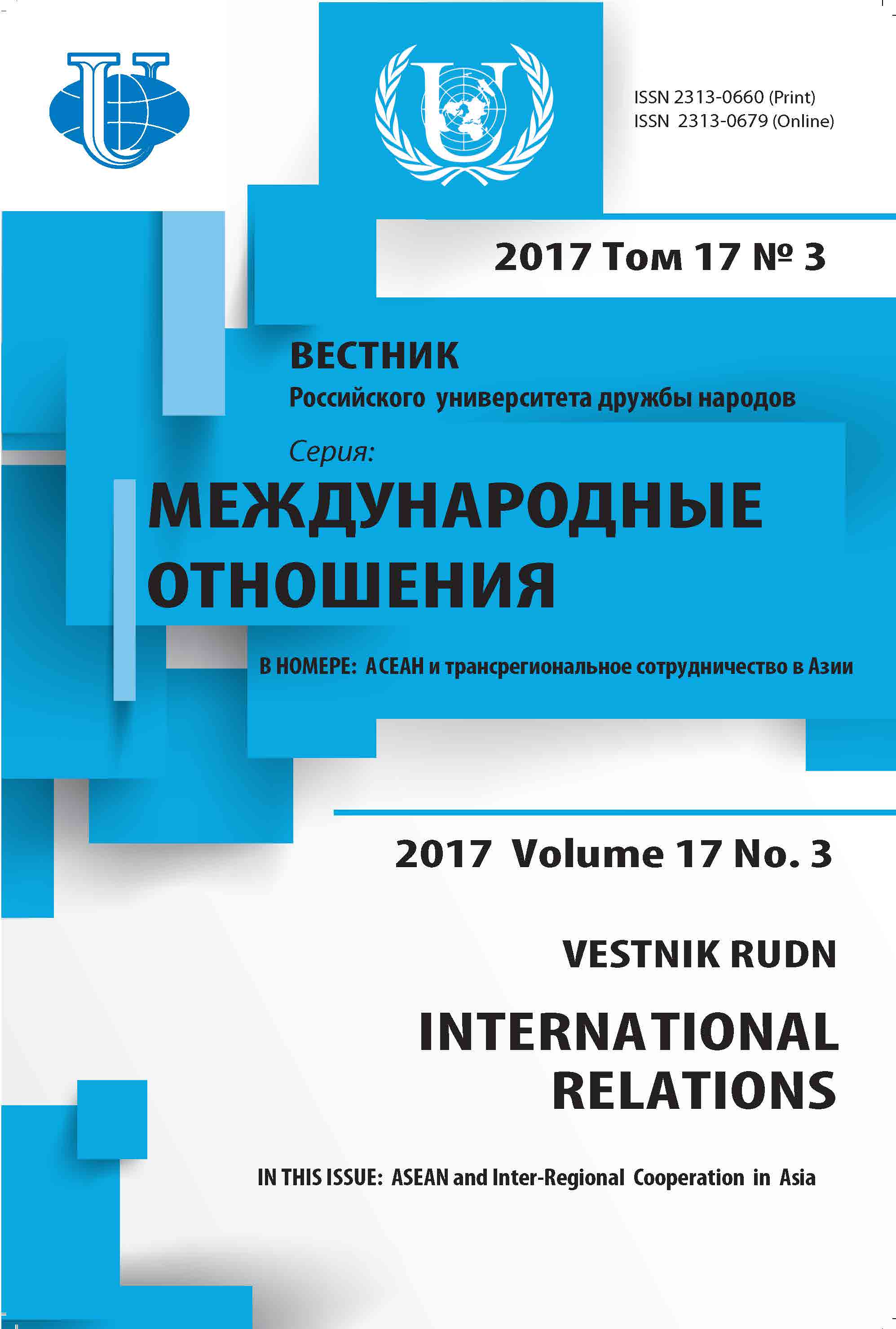ASEAN-LED MULTILATERAL SECURITY DIALOGUE: EURASIAN PRIORITIES
- Authors: Kanaev EA1, Shumkova VA1
-
Affiliations:
- National Research University Higher School of Economics, Moscow, Russia
- Issue: Vol 17, No 3 (2017): ASEAN and Inter-Regional Cooperation in Asia
- Pages: 458-468
- Section: THEMATIC DOSSIER
- URL: https://journals.rudn.ru/international-relations/article/view/16759
- DOI: https://doi.org/10.22363/2313-0660-2017-17-3-458-468
Cite item
Full Text
Abstract
The article focuses upon new aspects in ASEAN priorities relevant to the rise of efficiency of ASEAN-led multilateral dialogues platforms - ASEAN Regional Forum (ARF), ASEAN Defense Ministers Meeting Plus Eight (ADMM+8) and East Asia Summit (EAS). Having outlined the conceptual contradiction between the rise of the global component in Asia-Pacific security challenges, the authors trace the intellectual and practical dimensions of ASEAN response. On reviewing the key directions of intra-ASEAN expert discussions, the authors reveal their qualitatively new component - to link the modi-fication of ASEAN modality of cooperation and its expansion to the Eurasian area. The trace of factors responsible for the possibility and necessity to adopt ARF, ADMM+8 and EAS to the impeding format ASEAN-SCO-EAEU and practically-oriented proposals about the promising directions of cooperation within this format are the key academic value-added of the study. The actuality and academic significance of the study stem from the necessity to analyze issues important for ASEAN and its Eurasian partners. Among these issues, the key are: which directions of cooperation can be of help for ASEAN in order to strengthen its positions as the driving force of Asia-Pacific multilateral dialogue frameworks? By what means can ASEAN and ASEAN-led formats be integ-rated in the establishment of Greater Eurasia with the maximum outcomes for both ASEAN and its Eurasian partners? How can ASEAN experience be used for the establishment of an efficient trans-continental rather than regional multilateral security dialogue? Findings on these issues make the article academi-cally unique.
Keywords
About the authors
E A Kanaev
National Research University Higher School of Economics, Moscow, Russia
Author for correspondence.
Email: E.a.kanaev@gmail.com
Doctor of History, Professor, Head of Asia- Pacific Division, Centre for Comprehensive European and International Studies, Faculty of World Economy and International Affairs, National Research University Higher School of Economics
V A Shumkova
National Research University Higher School of Economics, Moscow, Russia
Email: vshumkova@hse.ru
Research Assistant, Centre for Comprehensive European and International Studies, Faculty of World Economy and International Affairs, National Research University Higher School of Economics
References
- Caballero-Anthony, M. (2014). Understanding ASEAN's centrality: bases and prospects in an evolving regional architecture. The Pacific Review, 27, 563—584. doi: 10.1080/09512748.2014.924227.
- Chalermpalanupap, T. (2013). ASEAN Defence Diplomacy and the ADMM-Plus. ISEAS Perspec¬tive, 49, 1— 6.
- Chen, X. & Stone, C. (2013). China and Southeast Asia: Unbalanced Development in the Greater Mekong Subregion. Trinity College Digital Repository. URL: http://digitalrepository.trincoll.edu/ cgi/viewcontent.cgi?article=1084&context=facpub (accessed: 14.06.2017).
- Dang, C.T. (2016). Regional strategic challenges and East Asia Summit. PacNet, Center for Strategic and International Studies, N 42.
- Heng, P.K. (2014). The “ASEAN Way” and Regional Security Cooperation in the South China Sea. European University Institute Working Papers. URL: http://cadmus.eui.eu/bitstream/handle/1814/ 33878/RSCAS_2014_121.pdf;sequence=1 (accessed: 14.06.2017).
- Hoang, T.H. (2017). Reconciling Consensus with New Realities. ASEAN Focus, 1, 2—7.
- Hoang, T.H. (2016). The Politics and Processes of the East Asia Summit. ASEAN Focus, 10, 4—5.
- Hoang, T.H., Thuzar, M., Basu Das, S. & Chalermpalanupap, T. (2016) ASEAN’s Reflections from Brexit. ASEAN Focus, 6, 19—21.
- Karaganov, S. (2014). The Watershed Year: Interim Results. Russia in Global Affairs, 4, 8—19.
- Kausikan, B. (2016). What Will the Trump Presidency Mean for ASEAN? ASEAN Focus, 8, 2—7.
- Lokshin, G.M. (2013). ASEAN and Territorial Disputes in South China Sea. Southeast Asia: topical problems of development, 20, 17—39. (In Russ.).
- Mikheev, V.V. & Shvydko, V.G. (Eds.). (2014). Imbalances of the trans-Pacific space. Moscow: Magistr. (in Russ.).
- Mikhnevich, S.V. (2016). The Glory of Intelligence: China's Smart Power and the Implications for Security in the Asia-Pacific Region. International Organizations Research Journal, 1, 92—125. (In Russ.).
- Pambagyo, I. (2017). RCEP is the Only Game in Town. ISEAS Focus, 2, 26—27.
- Sukma, R. (2016). A post-ASEAN regional order in East Asia? Centre for Strategic and International Studies. URL: https://www.csis.or.id/publications/page/a_post-asean_regional_order_in_east_ asia_.html (accessed: 15.06.2017).
- Thayer, C.A. (2013). ASEAN, China and the Code of Conduct in the South China Sea. SAIS Review of International Affairs, 2, 75—84.











